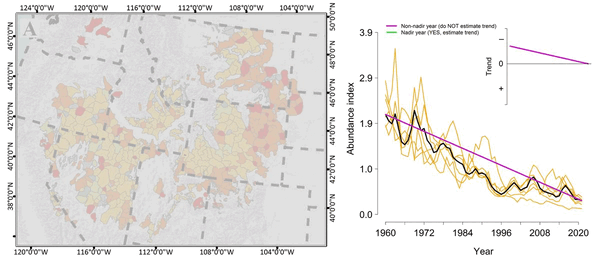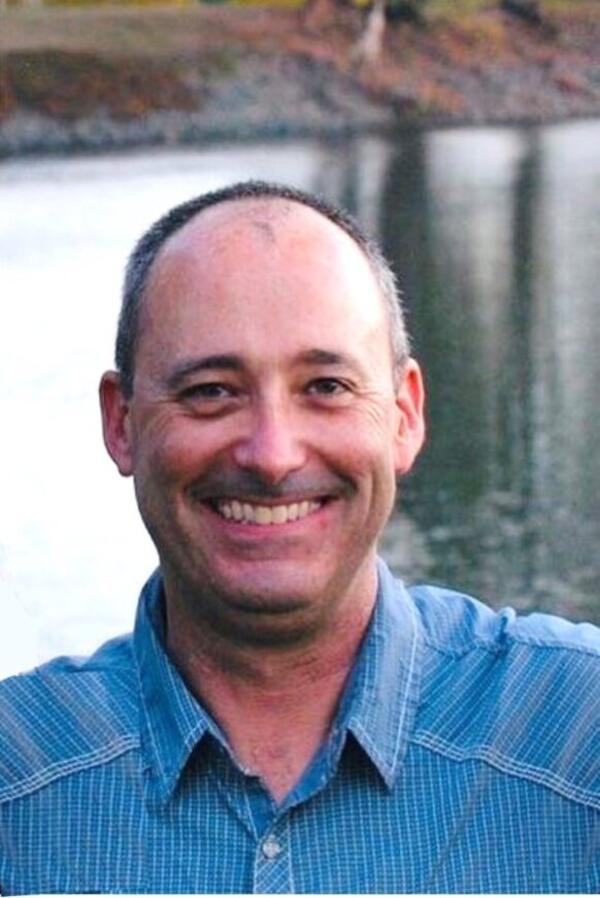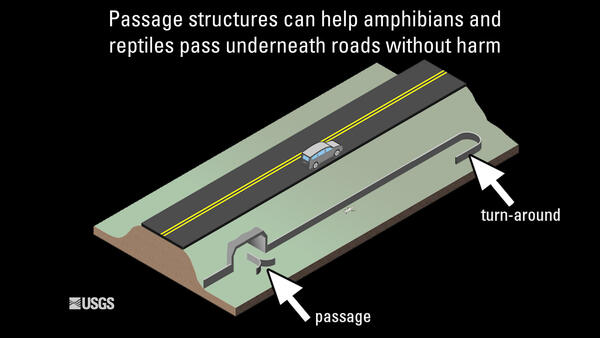This gif provides a preview of the output of the trends application and shows how a user can click between tabs in the tool to access the results. The tool allows the user to explore population abundance and growth rates within their area of interest across all population low points. The tool outputs are provided in map, figure, and table formats.
Multimedia
Learn more about our science in action in the field and laboratory. Check out some of our available photos and videos. For more information, e-mail werc_web@usgs.gov
Images
This gif provides a preview of the output of the trends application and shows how a user can click between tabs in the tool to access the results. The tool allows the user to explore population abundance and growth rates within their area of interest across all population low points. The tool outputs are provided in map, figure, and table formats.

Trend estimation calculated from seven nadirs defining six unique periods of complete population oscillation
linkTrend estimation calculated from seven nadirs defining six unique periods of complete population oscillation. Purple lines indicate periods of erroneous inference about population trend. Green lines indicate nadir-to-nadir inference and more accurate trend estimation.
Trend estimation calculated from seven nadirs defining six unique periods of complete population oscillation
linkTrend estimation calculated from seven nadirs defining six unique periods of complete population oscillation. Purple lines indicate periods of erroneous inference about population trend. Green lines indicate nadir-to-nadir inference and more accurate trend estimation.

Damian Higgins serves as one of two Research Managers for the USGS Western Ecological Research Center.
Damian Higgins serves as one of two Research Managers for the USGS Western Ecological Research Center.

Each dot is a GPS location collected between 2015-2023.
Each dot is a GPS location collected between 2015-2023.
A team of biologists prepares to measure, weigh, and tag a captured bats. On the left, USGS biologist Gabe Reyes has a bat in a bag, used to separate and calm the bats. USGS biologist Julia Ersan is holding some alcohol used to ensure clean instruments and work surfaces, and USGS biologist Austin Waag is getting something out of a backpack.
A team of biologists prepares to measure, weigh, and tag a captured bats. On the left, USGS biologist Gabe Reyes has a bat in a bag, used to separate and calm the bats. USGS biologist Julia Ersan is holding some alcohol used to ensure clean instruments and work surfaces, and USGS biologist Austin Waag is getting something out of a backpack.
A female Wilson’s phalarope with 2-gram Sunbird PTT transmitter. Wilson's phalaropes spin around in the water to stir up invertebrates to snack on. Large flocks gather on terminal lakes in the American west before migrating as far as southern most South America.
A female Wilson’s phalarope with 2-gram Sunbird PTT transmitter. Wilson's phalaropes spin around in the water to stir up invertebrates to snack on. Large flocks gather on terminal lakes in the American west before migrating as far as southern most South America.
Videos
 Scientists Release Mountain Yellow-Legged Froglets into Stream
Scientists Release Mountain Yellow-Legged Froglets into Stream
This video captures a moment when USGS scientist Elizabeth Gallegos released 8 zoo-raised froglets into a stream, just one of several such reintroductions last summer. The long-term goal is to create 25 populations of a few hundred to a thousand frogs each. This summer, the team will revisit the sites to see how the frogs are doing.
This video captures a moment when USGS scientist Elizabeth Gallegos released 8 zoo-raised froglets into a stream, just one of several such reintroductions last summer. The long-term goal is to create 25 populations of a few hundred to a thousand frogs each. This summer, the team will revisit the sites to see how the frogs are doing.
This video shows a California tiger salamander finding its way to an underpass designed to help amphibians and reptiles cross the road safely, with the help of a "turn-around" that helps guide the salamander back in the right direction as it travels away from the underpass.
This video shows a California tiger salamander finding its way to an underpass designed to help amphibians and reptiles cross the road safely, with the help of a "turn-around" that helps guide the salamander back in the right direction as it travels away from the underpass.
This video provides background on and shows the release of California red-legged frog tadpoles into a pond in San Diego County, CA on March 31, 2021.
This video provides background on and shows the release of California red-legged frog tadpoles into a pond in San Diego County, CA on March 31, 2021.
 Count the bats -- how do your skills compare to a bat biologist's?
Count the bats -- how do your skills compare to a bat biologist's?
Do you have what it takes to be a bat biologist? USGS bat researchers are counting Townsend’s big eared bats to monitor how their populations are doing. Watch the video to try your hand at a bat count and see how your skills compare to a USGS scientist!
Do you have what it takes to be a bat biologist? USGS bat researchers are counting Townsend’s big eared bats to monitor how their populations are doing. Watch the video to try your hand at a bat count and see how your skills compare to a USGS scientist!
 Wintering Waterfowl at Sacramento National Wildlife Refuge
Wintering Waterfowl at Sacramento National Wildlife Refuge
In this video, you can hear the honks and quacks of geese and ducks ring through the air, as birds fly in every direction above a wetland. This video was captured at Sacramento National Wildlife Refuge in November 2019, not long after geese and ducks began to arrive to spend the winter in the California Central Valley.
In this video, you can hear the honks and quacks of geese and ducks ring through the air, as birds fly in every direction above a wetland. This video was captured at Sacramento National Wildlife Refuge in November 2019, not long after geese and ducks began to arrive to spend the winter in the California Central Valley.
 Sea-Level Rise, El Niño, and Storm Effects on Coastal Tidal Marshes
Sea-Level Rise, El Niño, and Storm Effects on Coastal Tidal Marshes
Tidal marshes exist as a transitional environment between the land and sea, and provides habitat to fish and wildlife, protects human developments from coastal flooding, and stores carbon at high density, among other important ecosystem services.
Tidal marshes exist as a transitional environment between the land and sea, and provides habitat to fish and wildlife, protects human developments from coastal flooding, and stores carbon at high density, among other important ecosystem services.
Audio
Bats produce a variety of vocalizations that are used for navigation, feeding, and social communication. Most vocalizations are pitched well above the range of human hearing and are referred to as ultrasonic.
Bats produce a variety of vocalizations that are used for navigation, feeding, and social communication. Most vocalizations are pitched well above the range of human hearing and are referred to as ultrasonic.
Bats produce a variety of vocalizations that are used for navigation, feeding, and social communication. Most vocalizations are pitched well above the range of human hearing and are referred to as ultrasonic.
Bats produce a variety of vocalizations that are used for navigation, feeding, and social communication. Most vocalizations are pitched well above the range of human hearing and are referred to as ultrasonic.
Bats produce a variety of vocalizations that are used for navigation, feeding, and social communication. Most vocalizations are pitched well above the range of human hearing and are referred to as ultrasonic.
Bats produce a variety of vocalizations that are used for navigation, feeding, and social communication. Most vocalizations are pitched well above the range of human hearing and are referred to as ultrasonic.
Bats produce a variety of vocalizations that are used for navigation, feeding, and social communication. Most vocalizations are pitched well above the range of human hearing and are referred to as ultrasonic.
Bats produce a variety of vocalizations that are used for navigation, feeding, and social communication. Most vocalizations are pitched well above the range of human hearing and are referred to as ultrasonic.
Bats produce a variety of vocalizations that are used for navigation, feeding, and social communication. Most vocalizations are pitched well above the range of human hearing and are referred to as ultrasonic.
Bats produce a variety of vocalizations that are used for navigation, feeding, and social communication. Most vocalizations are pitched well above the range of human hearing and are referred to as ultrasonic.
This is the call of the elusive Ashy Storm-Petrel (Oceanodroma homochroa). Ashy Storm-Petrels nest in burrows and crevices on offshore rocks and islands. To avoid predators, they only arrive and depart their island nests under the cover of darkness. That makes studying them pretty difficult.
This is the call of the elusive Ashy Storm-Petrel (Oceanodroma homochroa). Ashy Storm-Petrels nest in burrows and crevices on offshore rocks and islands. To avoid predators, they only arrive and depart their island nests under the cover of darkness. That makes studying them pretty difficult.








